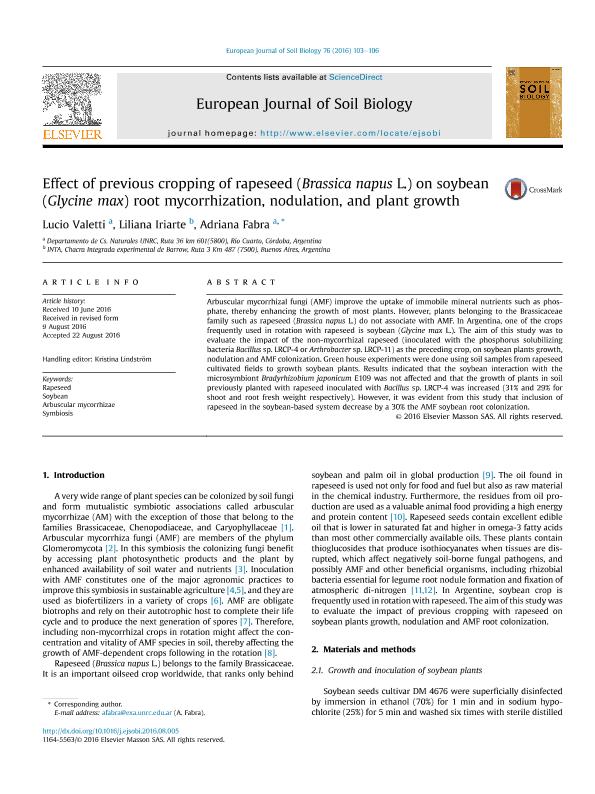Artículo
Effect of previous cropping of rapeseed (Brassica napus L.) on soybean (Glycine max) root mycorrhization, nodulation, and plant growth
Fecha de publicación:
08/2016
Editorial:
Elsevier France-Editions Scientifiques Medicales Elsevier
Revista:
European Journal Of Soil Biology
ISSN:
1164-5563
Idioma:
Inglés
Tipo de recurso:
Artículo publicado
Clasificación temática:
Resumen
Arbuscular mycorrhizal fungi (AMF) improve the uptake of immobile mineral nutrients such as phosphate, thereby enhancing the growth of most plants. However, plants belonging to the Brassicaceae family such as rapeseed (Brassica napus L.) do not associate with AMF. In Argentina, one of the crops frequently used in rotation with rapeseed is soybean (Glycine max L.). The aim of this study was to evaluate the impact of the non-mycorrhizal rapeseed (inoculated with the phosphorus solubilizing bacteria Bacillus sp. LRCP-4 or Arthrobacter sp. LRCP-11) as the preceding crop, on soybean plants growth, nodulation and AMF colonization. Green house experiments were done using soil samples from rapeseed cultivated fields to growth soybean plants. Results indicated that the soybean interaction with the microsymbiont Bradyrhizobium japonicum E109 was not affected and that the growth of plants in soil previously planted with rapeseed inoculated with Bacillus sp. LRCP-4 was increased (31% and 29% for shoot and root fresh weight respectively). However, it was evident from this study that inclusion of rapeseed in the soybean-based system decrease by a 30% the AMF soybean root colonization.
Palabras clave:
ARBUSCULAR MYCORRHIZAE
,
RAPESEED
,
SOYBEAN
,
SYMBIOSIS
Archivos asociados
Licencia
Identificadores
Colecciones
Articulos(CCT - CORDOBA)
Articulos de CTRO.CIENTIFICO TECNOL.CONICET - CORDOBA
Articulos de CTRO.CIENTIFICO TECNOL.CONICET - CORDOBA
Citación
Valetti, Lucio; Iriarte, Liliana Beatriz; Fabra, Adriana Isidora; Effect of previous cropping of rapeseed (Brassica napus L.) on soybean (Glycine max) root mycorrhization, nodulation, and plant growth; Elsevier France-Editions Scientifiques Medicales Elsevier; European Journal Of Soil Biology; 76; 8-2016; 103-106
Compartir
Altmétricas




